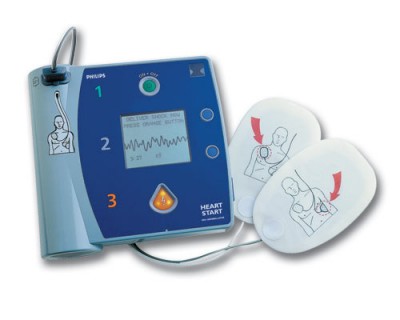The Korey Stringer Institute has taken the existing literature and consolidated it to create 8 key points when considering state policy on automated external defibrillators (AEDs) in secondary schools. These devices can be the difference between life and death for athletes who experience sudden cardiac arrest or commotio cordis. In terms of treatment of sudden cardiac arrest or commotio cordis, use of an AED with cardiopulmonary resuscitation (CPR) is the gold standard. With EMS an average of 7-8 minutes away from the scene, the responsibility of initiating pre-hospital care falls to the on-site medical staff, coaches, athletes, administrators, or other bystanders.
The rate of survival from sudden cardiac arrest falls 7-10% for each minute without CPR. That would mean that if CPR was delayed even 3 minutes, the injured person now has a 70% chance of survival.
While CPR is absolutely necessary and important, the use of an AED increases the rate of survival. This information is intended to take the most reasonable and effective current guidelines and create state policies that save lives. As sudden cardiac death is the leading cause of death in sport, having precautionary measures in place helps not only the athletes, but also the medical staff and school/event administration.
The American Heart Association (AHA) recommends a five-part chain of survival for effective emergency cardiac care:
- Immediate recognition and activation of EMS
- Early CPR
- Rapid defibrillation with an AED, when indicated
- Effective advanced life support (including airway management and ventilation support)
- Integrated post-cardiac arrest care
Within these steps, implementation of rapid defibrillation requires consideration of the following key points for AED policies at your venue.
- AEDs are to be used under the advice, guidance and consent of a physician by individuals with proper training and certification. They have the potential to be dangerous if used improperly or by untrained individuals.
- Athletic trainers, coaches, administrators, school nurses, and physical education teachers should have access to an AED on school property and at all school athletic events/activities. These individuals should be provided annual training and certification in CPR and AED use.
- AED is to be stored in a safe (protected from snow, rain, sun, etc.) and easily accessible place. Institutions that are sponsoring athletic events, should have an AED on site or access to one at each athletic venue to practices and games.
- The location of the AED should be well marked, publicized, and known among athletic staff. It is critical that the location is close enough to the venue that it takes no longer than 5 minutes from the time of collapse to the first administered shock. Ensure the device is visible to the public and easily recognizable in an emergency.
- AED is to be used after activating EMS. Another athletic trainer, coach, athlete or bystander may perform this action.EMS can be called by anyone on-site, they do not need to be trained in CPR/AED administration. AED use is a supplemental treatment until further medical care is on-site.
*Activating EMS:
- 911 should be called immediately, prior to using an AED
- Be prepared to answer questions about the location of the victim, the condition of the victim and what treatments are being given.
- If more than one person is with the victim, someone can be designated to retrieve the AED while another begins CPR and AED usage.
AEDs should be inspected frequently to ensure proper working order!!!
- Ensure batteries are charged and have not expired
- Wires, electrodes, pads are in good and working condition
- Ensure “AED kit” is stocked and includes: electrodes/pads (child & adult), CPR mask, gloves, scissors, razor, towel, antiperspirant (reduce sweating and help pad adherence) and antimicrobial wipes.
- These items should be checked at least monthly and documented each time.
References
- Abella BS, Aufderheide TP, Eigel B, et al. Reducing Barriers for Implementation of Bystander-Initiated Cardiopulmonary Resuscitation: A Scientific Statement from the American Heart Association for Healthcare Providers, Policymakers, and Community Leaders Regarding the Effectiveness of Cardiopulmonary Resuscitation.Circulation. 2008;117:704-709.
- Balady GJ, Chaitman B, Foster C, et al. Automated External Defibrillators in Health/Fitness Facilities. Med Sci Sports Exerc, 2002;34(3):561-564.
- Balady GJ, Chaitman B, Driscoll D, et al. AHA/ACSM Joint Position Statement: Recommendations for Cardiovascular Screening, Staffing, and Emergency Policies at Health/Fitness Facilities. Med Sci Sports Exerc, 1998;30(6):1009-1018.
- Drezner JA, Courson RW, Roberts WO, et al. Inter-Association Task Force Recommendations on Emergency Preparedness and Management of Sudden Cardiac arrest in High School and College Athletic Programs: A Consensus Statement. J Athl Train, 2007;42(1):143-158.
- Rothmier JD and Drezner JA. The Role of Automated External Defibrillators in Athletics. Sports Health, 2009;1(1):16-20.
- Thompson PD, Franklin BA, Balady GJ, et al. Exercise and Acute Cardiovascular Events: Placing the Risks into Perspective. Med Sci Sports Exerc, 2007;39(5):886-897.
- Valenzuela TD, Roe DJ, Cretin S, et al. Estimating effectiveness of cardiac arrest interventions: a logistic regression survival model. Circulation. 1997;96:3308 –3313.
